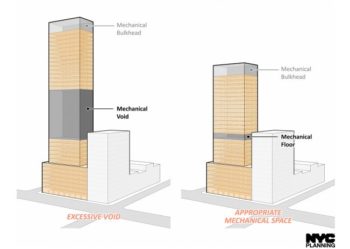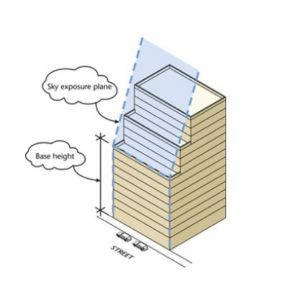
Building on left demonstrates current issue with excessive mechanical voids. Image Credit: NYC CPC
Developers were using excessive mechanical spaces to increase the height of their buildings. On May 29, 2019, the City Council voted to adopt the Residential Tower Mechanical Voids Text Amendment with modifications. The Department of City Planning proposed the amendment in response to developers incorporating excessively tall mechanical floors – “mechanical voids” – in residential towers to increase their allowable height, as mechanical floors did not count toward the zoning floor area in the Zoning Resolution. This would result in towers with several floors of mostly empty space that would allow developers to build higher, increasing the values of the apartments on higher floors. In late 2018, Mayor Bill de Blasio asked the Department of City Planning (DCP) to investigate the mechanical voids problem and find a solution.
On January 28, 2019, the City Planning Commission certified DCP’s application for a zoning text amendment of R9, R10, their equivalent commercial districts, and special purpose districts. Unlike smaller zoning districts that provide maximum height restrictions, buildings in R9 and R10 districts and commercial equivalents are governed by the sky exposure plane. Currently, these districts only exist in Manhattan, Queens and the Bronx.

Diagram of the sky exposure plane. Buildings currently in districts included in the amendment can build beyond the sky exposure plane. Image Credit: NYC CPC
The mechanical voids text amendment discourages mechanical voids of over 25 feet in residential buildings by providing that voids over 25 feet tall will count toward the zoning floor area. Additionally, mechanical void spaces located within 75 feet of each other in residential buildings will also count as zoning floor area to discourage the clustering of void spaces. In mixed-use buildings, non-residential mechanical space will also be subject to the 25-foot limit if non-residential uses occupy less than 25 percent of the building.
As part of the public review process, throughout February and early March, 13 different affected Community Boards adopted resolutions regarding the proposed amendment. Bronx Community Board 4, Manhattan Community Boards 1, 3, 6, 7, 8, 10, 11, and Queens Community Boards 2 and 12, all voted to recommend approval with various recommendations or conditions and little to no opposition. Manhattan Community Boards 2, 4, and 5 all voted to disapprove with conditions. Many of the conditions that community boards recommended included reducing the mechanical space height limit to a range of 12 to 15 feet instead of 25 feet. Other boards requested a percentage limit on the amount of mechanical space allowed overall. A few others asked that the amendment apply to all zoning districts, not just the districts currently listed in the amendment.
The application was then presented to the Bronx, Queens and Manhattan Borough Presidents. On March 8, 2019, Manhattan Borough President Gale Brewer recommended approval of the application with conditions, including increasing the clustering threshold from 75 feet to 90 feet. The Bronx and Queens Borough Presidents did not issue recommendations.
On March 13, 2019, the City Planning Commission held a public hearing for the application. There were 23 speakers in support, including Borough President Brewer, Council Member Ben Kallos, Manhattan neighborhood associations, and local residents. There were 18 speakers in opposition including engineers, architects, land use attorneys and a Manhattan preservation group. While all speakers agreed that excessive voids were a problem, those in support wished the restrictions would extend further; those in opposition argued the 25-foot threshold was too restrictive. Some of the engineers and architects in opposition testified that industry best practices require flexibility with mechanical spaces. On April 10, 2019, the City Planning Commission voted to approve a modified application that increased the 25-foot mechanical space height threshold to 30 feet.
City Council held a public hearing on the application on April 16, 2019. On May 29, 2019, the City Council voted to approve the application with modifications. City Council voted to adjust the City Planning-approved 30-foot mechanical space height back to the originally proposed 25 feet. The application received 47 votes in support and one in opposition. Council Member Inez D. Barron was the sole vote against the application, claiming that the limit of 25 feet was not restrictive enough and that those empty spaces could be used for additional apartments.
Council Member Ben Kallos, who advocated for the application stated, “Today, by strengthening and passing the proposal to limit the height of mechanical voids to 25 feet, we are taking a significant step forward toward stopping developers from getting around the zoning to give billionaires views instead of building affordable housing for New Yorkers. This is only a start. We need to go much further by holding City Planning to its promise to expand this change to commercial districts this summer and to address unenclosed voids and ‘gerrymandered’ zoning lots that were first identified in my district. There is something wrong when developers would rather build empty spaces to prop up the wealthy rather than building the affordable housing that 99% of New Yorkers need.”
By: Veronica Rose (Veronica is the CityLaw fellow and a New York Law School graduate, Class of 2018.)

